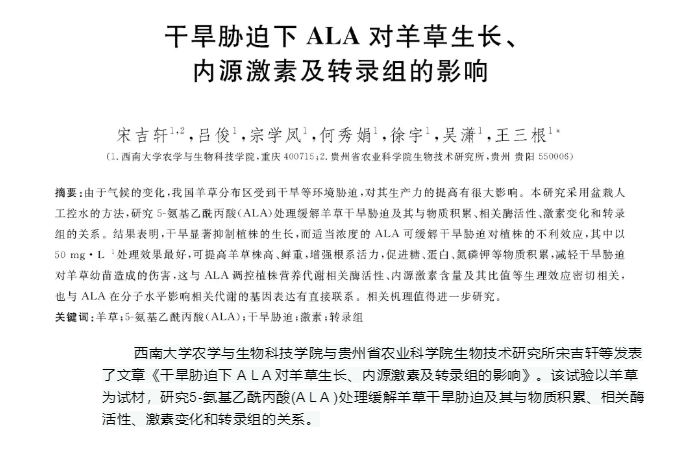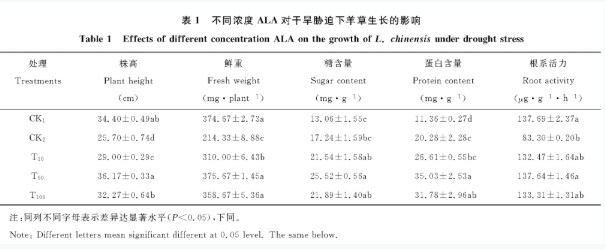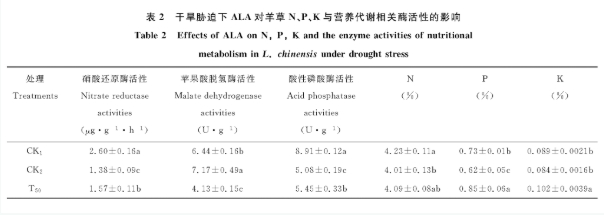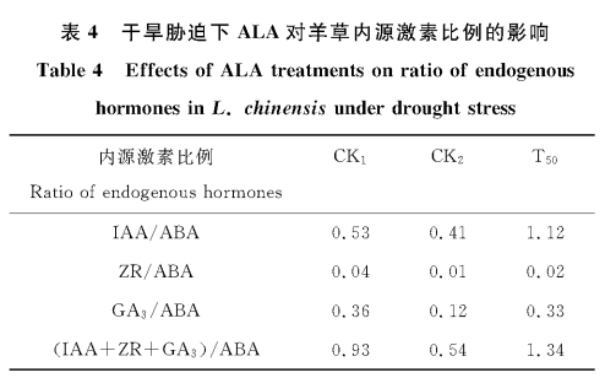
1. Effects of 5-ALA on plant growth of Leymus chinensis under drought stress

As can be seen from the table, the plant height and fresh weight of Leymus chinensis seedlings after drought stress (CK) were significantly reduced, and the difference was significant compared with that of CK 1. Meanwhile, the root activity was also significantly decreased. However, the sugar and protein content of the plants increased significantly. After treatment with different concentrations of A L A, these indexes have a certain increase compared with CK, and some of them reach a significant difference level compared with CK. It is worth noting that when the concentration of A-L was 50 mg • L(T50 treatment), all indexes reached the maximum, and the plant height, fresh weight and root activity indexes even exceeded or were comparable to CK1, and the content of sugar and protein also reached the maximum.
2. Effects of 5-A L-1 on enzyme activities related to nitrogen, phosphorus, potassium and nutrient metabolism of Leymus chinensis under drought stress

As can be seen from the table, nitrogen and phosphorus contents of Leymus chinensis seedlings (CK2) decreased under drought, and both reached significant differences compared with CK1. The K content decreased slightly. The contents of nitrogen, phosphorus and potassium were all increased to varying degrees after treatment with A L A(T50), especially the contents of phosphorus and potassium were not only significantly higher than CK2, but also exceeded CK1. Compared with drought-stressed CK2 and control CK1, the P content of T50 treated plants increased by 37.1% and 16.4%, respectively. K content increased by 21.4% and 14.6%, respectively.
3. Effects of 5-A L on endogenous hormones of Leymus chinensis under drought stress

It can be seen from the table that the contents of plant endogenous hormones such as abscisic acid (ABA), indole acetic acid (IAA), gibber (GA3) and zeatin (ZR) of Leymus chinensis had great changes after drought stress (CK). ABA and IAA were significantly increased, while GA3 and ZR were significantly decreased. After ALA(T50) treatment, the endogenous hormone content of plants was further changed. For example, ABA content decreased, but was still higher than CKi; IAA, GA3 and ZR were increased. In particular, IAA content reached the maximum, increasing by 100.3% and 158.5% compared with CK2 and CK1, respectively.

As can be seen from the table, drought stress also changed the ratios of growth and cell division hormones (IAA, GA3 and ZR) and ABA in L. chinensis seedlings. After drought stress (CK"), the ratio of IAA/ABA, ZR/ABA and GA3/ABA decreased compared with normal water treatment (CK), and the total value of IAA+ZR+GA3 /ABA was only 58% of that of CKi. When treated with ALA(T50), the IAA/ABA, ZR/ABA and GA(/ABA) values of the plants exceeded CK2, and IAA/ABA also exceeded CKi. The calculated total (IAA+ZR+GA3)/ABA value increases by 148% compared to CK2 and even 44% compared to CK1.
The results showed that drought significantly inhibited plant growth, and appropriate concentration of A L could alleviate the adverse effects of drought stress on plants, among which 50 m g.L L was the best treatment, which could increase plant height and fresh weight, enhance root vitality, promote the accumulation of sugar, protein, nitrogen, phosphorus and potassium, and alleviate the damage caused by drought stress on Chinensis chinensis seedlings.